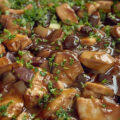To make Jewish rye bread the most authentic way possible it is best to use a sourdough starter and a longer fermentation, but we know that’s not practical for most people, so we did a modification. Traditionally Jewish rye bread was usually made with caraway seeds and that is why many of us associate the flavor of those seeds with the bread, but if you're not a fan, you can leave them out. For this recipe we put them on top to flavor the crust, but feel free to add them into the dough when adding oil.
Dark rye retains the germ and bran similar to whole wheat, so it has more flavor and given we are only using a small percentage I highly recommend the added nutritional value and flavor that comes from using dark rye flour.
We baked this bread in a Dutch oven to achieve a nice crispy crust, but if you like a softer sandwich style bread you can make it in a loaf pan.
Are you wondering What makes Rye Bread Jewish? Find out here.
Adapted from Rose Levy Beranbaum’s Real Jewish Rye Bread.
Ingredients
Sponge
- ¾ cup 117 g bread flour
- ¾ cup 95 g rye flour
- ½ teaspoon 1.6 g instant yeast
- 1 ½ tablespoons 18.7 g sugar
- ½ tablespoon 10.5 g barley malt syrup (or honey or sugar)
- 1 ½ cups water 354 g, at room temperature
Bread
- 2 ¼ cups 351 grams bread flour
- ½ teaspoon plus ⅛ teaspoon 2 g instant yeast
- 1 ½ teaspoons 10.5 g salt
- 1 ½ teaspoons 6.7 g vegetable oil
- 2 tablespoons 14 g caraway seeds (optional)
Nutritional Facts
Instructions
- Make the sponge, this is in place of having a sourdough starter: In the bowl of a stand mixer, or in a large bowl, combine the bread flour, rye flour, yeast, sugar, malt syrup and water. Whisk until very smooth, scraping down the sides of the bowl. The starter will have the consistency of thick batter. Cover the bowl with plastic wrap, and set the sponge aside while you combine the flour mixture.
- In a large bowl, whisk together bread flour, yeast, and salt. Remove the plastic wrap from the sponge, and gently scoop the flour mixture over the sponge to cover it completely. Cover tightly with plastic wrap and set it aside at room temperature to ferment until the sponge bubbles through the flour mixture in places, 1 to 4 hours, it will take longer if it is colder.
- In a stand mixer place the bowl with fermented sponge/flour mixture, add oil, with a dough hook knead over low speed until the flour is moistened enough to form a rough dough, about 1 minute. Increase the speed to medium and continue to mix until the dough is very smooth and elastic, and springs back when pressed with a fingertip, about 10 minutes. If the dough is at all sticky, turn it out onto a counter and knead in a little extra bread flour.
- Place the dough in a 2-quart bowl, lightly greased with oil. Press down the dough and lightly oil the top. Cover the bowl with plastic wrap or a damp towel. Set the dough aside to rise until doubled in size, 1 1/2 to 2 hours.
- Remove the dough to a well floured work surface. Shape the dough into a round oval and let it rest for 5 to 10 minutes. Line a proofing basket with a towel and sprinkle with flour. With floured hands, gently cup the dough and tighten to your desired shape. Spread caraway seeds on a damp kitchen towel. Lightly brush the surface of the dough with water. Using a bench scraper, place the dough onto the seeds, wet side down. Lift both sides of the towel and rock it back and forth to coat the dough. Place dough into proofing basket seam side up.
- Cover the dough and let rest about 45 minutes. Meanwhile, preheat oven to 450°F.
- Place a piece of parchment paper on the counter. Invert the bread onto the paper. Make three long cuts with a razor blade and place inside a Dutch oven. Place the covered pot into the hot oven and bake for 20 minutes. Remove lid, reduce temperature to 430°F and bake for another 25-30 minutes until golden brown.
- The finished loaf should be a deep golden brown when done; its internal temperature should be at least 205°F. Cool the bread on a rack overnight before slicing.
















